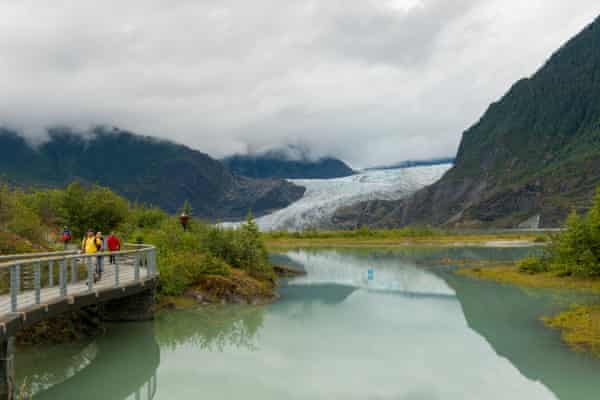In the beginning, there was only Niflheim, the realm of ice and cold and mists, and Muspelheim, the realm of fire. Between the two was a deep void through which a frozen river coursed. Out of the drips from this river was the first person born: Ymir, the ice giant whose thoughts were clouds.
This origin story makes particular sense in the land of its creators, Iceland, an island so obviously carved from ice and fire. But Earth itself is hostage to these two violent states, which have competed for precedence over our planet for billions of years.
Today, as we head into the Anthropocene, we are in the dying days of an era of ice that has lasted for 3m years, as we transition into an era of fire, a Pyrocene that may persist for tens of thousands of years. There are few places on our planet where ice still rules, and to visit them is to step into another world.
Glaciers are alive. They are the mighty beasts of Niflheim. They creak and roar, they creep and slide, flow and crack. They breathe. They breathe in the winter and breathe out the summer. Expanding as they inhale the snows of winter, and diminishing as they exhale in watery flows. Long feared by villagers, these expansions can devour whole communities, and the water left by their retreats holds its own terror, creating dammed lakes that can suddenly burst and wash away hundreds of years of human habitation.
Glaciers are the antithesis of life. This is the geology of the cold: vast ice sheets that survive only in the highest and most polar regions of our planet. Yet to enter this world of ice and rock is to experience the sublime. This is a sensory paradox of perspective-altering unreality: a monochrome landscape of countless hues; a featureless ice plain that transforms by the hour as the arcing sunlight is differentially scattered and captured, so that the intruder becomes quickly disoriented. And they are bright. Unbelievably bright, as though lit from beneath.
Walking across these undulating, unpredictable ice beasts is perilous – there are hidden crevasses that can swallow a person for ever. Yet we do it. I have made difficult pilgrimages to glaciers on four continents, compelled by the desire to simply stand in awe of their majesty, of their power and splendour.

Glaciers are old, sometimes many hundreds of thousands of years old. They are constructed of the air and water they have inhaled over these long lifetimes, physical memories that are stored as they grow in the layers of their geology. Scientists have drilled down through ancient glaciers to retrieve cores of ice through which they can glimpse the worlds that existed before us. Bubbles of air breathed out by giant sloths and cave bears, from worlds that were colder than today with less carbon dioxide.
There are creatures, too, micro-organisms held in suspended animation, frozen bacteria and algae. Our history is also recorded in the very recent layers. We see lead from Roman smelters two thousand years ago; signs of the plagues that devastated production, enabling vigorous forests to suck significantly more carbon dioxide from the air; the invention of toxic PCBs (polychlorinated biphenyls); nuclear tests; plastics; factory air pollution … It is all there, the creations and crimes of precocious species, marked in the glacial report card.
Long after the giant Ymir was born, the first humans emerged into a world dominated by ice, the Pleistocene. We puny, hairless, tropical primates managed to live across a planet, one-third of which was cloaked in ice, by adapting and evolving our cultural tools. We learned to thrive in an icy world, depicting it in meticulously observed cave paintings, and even using the ice to traverse oceans that separated continents.
But we are people of fire. We use the fires we create to defeat the ice world.

When the ice began retreating, 11,000 years ago at the start of the Holocene, we got our big break. We colonised those lands so recently occupied by ice that the ground still rises through relief of its weight. With our fires, we dominated the world, made the air and water and climate ours. It is the carbon dioxide we make that is inhaled by those few glaciers still remaining, still advancing, mostly retreating.
Yet we rely on the ice world that conceived us for our water – no other fresh water repository exists of that scale. As our frozen reservoirs disappear, so too our water. And they are retreating fast. Life is creeping up the snowline, into the barren icescapes. Some glaciers are turning pink and slushy as they melt, giving off the smell and appearance of watermelon, owing to algae that are newly able to grow there. People whose culture and livelihoods depend on the hardness and reliability of ice are having to migrate. A town in Iceland ran out of blue paint as artists tried to picture their newly coloured landscape.
We are entering an age of fire, the realm of Muspelheim. A hot world of higher seas and spreading deserts, made by us. Wildfires burn far into Siberia and across formerly frozen lands. The Arctic is melting a clear sea passage where an ice bridge once carried our ancestors.
Most glaciers have already vanished, leaving their mighty scars in the rocks and the shape of the once-powerful violence carved into the geology of our landscapes. One day, the majestic ice beasts that for me generated such heart-stopping awe will be reduced to nothing more than moraine – a pile of rubble at the foot of our human world.


Average Rating